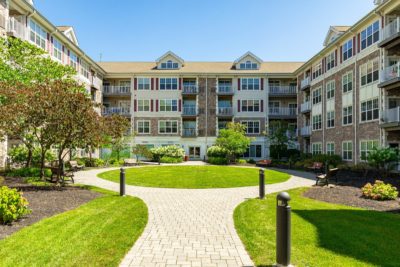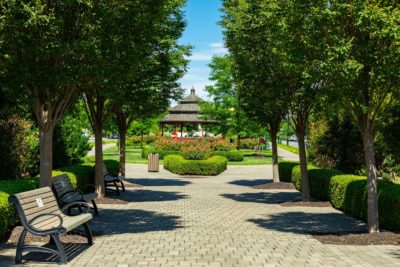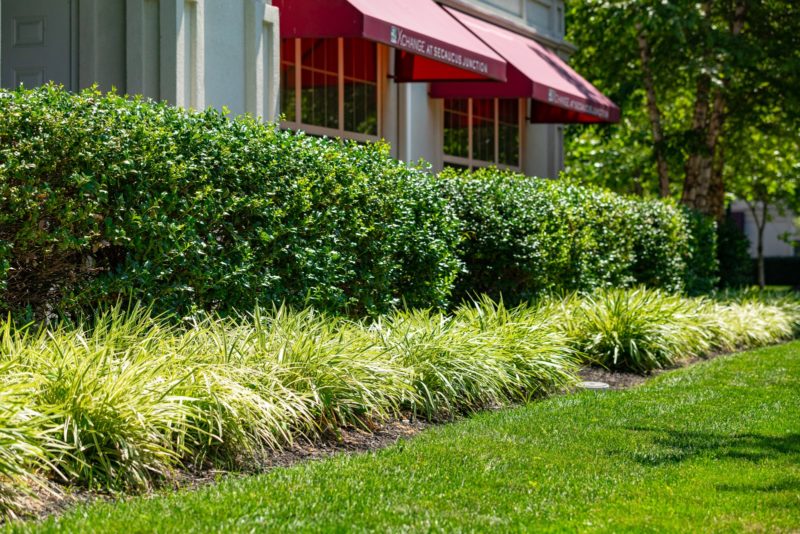 Fall feels like a welcome, crisp breeze after a rigorous summer of maintaining the curb appeal of your property—scheduled mowing, lawn care, pruning and taking care of details like edging. But autumn is still a growing season, and if you push the brakes on your fall lawn care schedule, you’ll pay for it in the spring.
Fall feels like a welcome, crisp breeze after a rigorous summer of maintaining the curb appeal of your property—scheduled mowing, lawn care, pruning and taking care of details like edging. But autumn is still a growing season, and if you push the brakes on your fall lawn care schedule, you’ll pay for it in the spring.
Consistency is key.
Fall lawn care is a continuation of your landscape maintenance program, with an emphasis on services that prepare your property to endure winter and thrive in the spring. Here are 10 fall lawn care tips to consider.
#1 Mow Regularly
Turf continues growing through fall, and it can even grow faster as we move out of dry summer weather and into September, when evening temperatures cool slightly and the ground retains more moisture. Our lawn care experts recommend mowing at the same height, not taking off more than 1/3 of the grass blade. The last mow of the season, we cut the grass shorter.
#2 Aerate the Lawn
 Fall is an ideal time to aerate your lawn to remove underlying thatch that causes compaction and prevents sun, oxygen and nutrients from reaching grass roots. Aeration encourages new turf growth and is a primer for overseeding. Property owners with lots of acreage might be tempted to skip lawn aeration to save on cost. However, not performing this essential cultural practice can result in losing part of your lawn, and replacement is a lot more expensive.
Fall is an ideal time to aerate your lawn to remove underlying thatch that causes compaction and prevents sun, oxygen and nutrients from reaching grass roots. Aeration encourages new turf growth and is a primer for overseeding. Property owners with lots of acreage might be tempted to skip lawn aeration to save on cost. However, not performing this essential cultural practice can result in losing part of your lawn, and replacement is a lot more expensive.
Seek out a lawn care pro that is equipped with the tools to evaluate soil for compaction and efficiently perform aeration.
#3 Overseed Your Property
Overseeding lawns helps fill in bare spots and rejuvenates tired turf with new, healthy growth. There is a right way to overseed; spraying an entire property with grass seed can be wasteful and ineffective. The approach we take is to identify weak areas of the lawn and bare spots that require topsoil. Preparing the ground for new seed is essential. We recommend overseeding because healthy, thick grass prevents weeds from cropping up. By overseeding, you basically take away available real estate for weeds to grow.
#4 Monitor Irrigation
Watering needs shift in fall, and a modern irrigation system with a smart controller and technology like rain sensors will ensure that you are not wasting this precious resource. Our lawns still need watering in fall. In fact, September can be a dry month. Not to mention, if your property was aerated and overseeded, watering is essential for growing new, healthy turf.
#5 Apply Fall Fertilizer
Lawn care doesn’t wrap up after Labor Day. In fact, fall is a great time to fertilize grass because it promotes root growth so your turf can sustain the winter. Also, with cooler temperatures and more moisture in fall, lawns soak in the nutrients from fertilizer (nitrogen, potassium and phosphorus). Of course, timing is everything. Fall fertilizer should go down at least a few weeks before the first freeze.
#6 Be Diligent with Leaf Cleanup
Should you wait until all of the leaves fall and hire a pro for one, big leaf cleanup? We certainly don’t recommend it. We understand why this seems like a good idea. Might as well hold off rather than asking a lawn care pro to perform the service over and over again, right? Not exactly. When leaves pile up on your lawn, they form a blanket that prevents sun, oxygen and nutrients from reaching the soil. Leaf cover can choke out your turf. Plus, after you invest in aeration and overseeding to grow new grass, it’s counterproductive to allow leaf cover to sabotage your efforts. Regular leaf cleanup keeps your commercial property looking its best during fall, too. And, if you stay on top of fall cleanup, you’ll avoid a labor-intensive and costly leaf cleanup at the end of the season.
#7 Prevent Winter Weeds
Fall pre-emergent herbicide prevents winter weeds like chickweed, clover and poa annua from germinating and emerging in early spring. You want to get ahead of those weeds, stopping them before they even start growing. If you wait until March or April, it’s too late. That is why fall pre-emergent is a necessary step in a comprehensive commercial lawn care service.
#8 Trim Trees and Shrubs
 A lawn care professional can identify tree limbs that are diseased, dying or dead and perform necessary pruning and trimming. We recommend removing potentially hazardous limbs before winter because the weight of snow and high winds can cause them to break off, damaging the tree and possibly causing property damage. Rather than dealing with storm damage cleanup, be proactive and address limbs that could be a liability.
A lawn care professional can identify tree limbs that are diseased, dying or dead and perform necessary pruning and trimming. We recommend removing potentially hazardous limbs before winter because the weight of snow and high winds can cause them to break off, damaging the tree and possibly causing property damage. Rather than dealing with storm damage cleanup, be proactive and address limbs that could be a liability.
#9 Mulch Landscape Beds
We usually think of mulching in spring when property owners order seasonal color for landscape beds. But mulching in fall is also beneficial because it helps protect plant roots from harsh winter conditions. Throughout the summer and during fall cleanup, mulch can disperse and wash out of beds. Even a light application (1 inch) can go a long way toward suppressing weed growth, retaining soil moisture and preventing erosion.
#10 Prepare for Snow Services
By now, you’ve probably secured your snow and ice management services for winter. Before the white stuff flies, a landscape professional will mark entrances and exits. At Neave, we perform a thorough inspection of your commercial property, identifying potential hazard zones and problem areas. This way, we can create a plan to efficiently remove snow and manage ice.
Leave the Fall Cleanup to Neave
We’ve got you covered this fall with comprehensive lawn care services to keep your commercial grounds looking great and growing strong. And, our staff has adopted necessary protocols to keep you safe and healthy. If you’re new to Neave, ask us about a free property assessment. Existing clients, we look forward to continuing to service your property.
Contact us at 845-463-0592 in Hudson Valley, 914-271-7996 in Westchester, 203-212-4800 in Connecticut and 201-591-4570 in New Jersey. Or, fill out our contact form and we’ll get in touch with you.